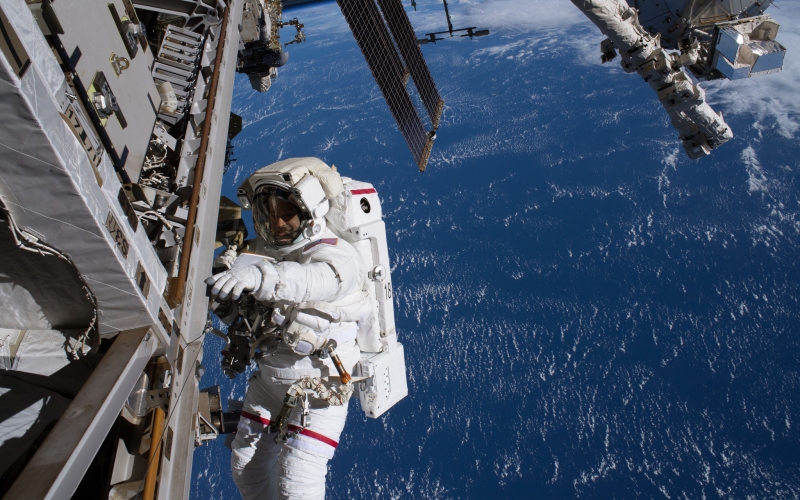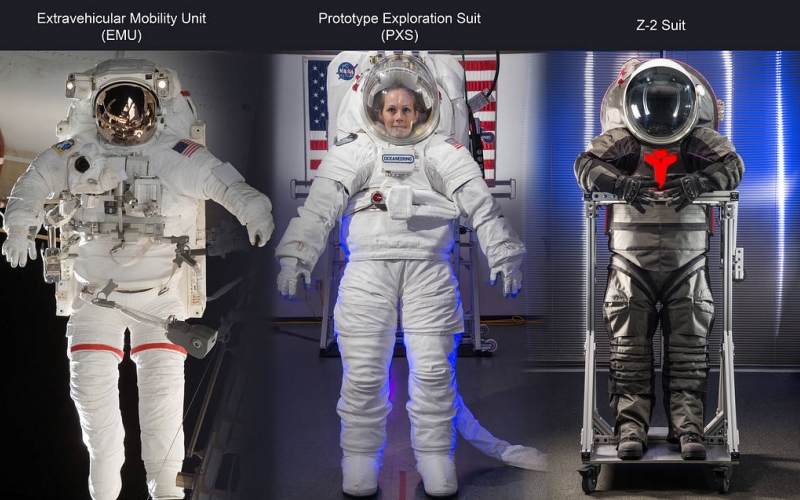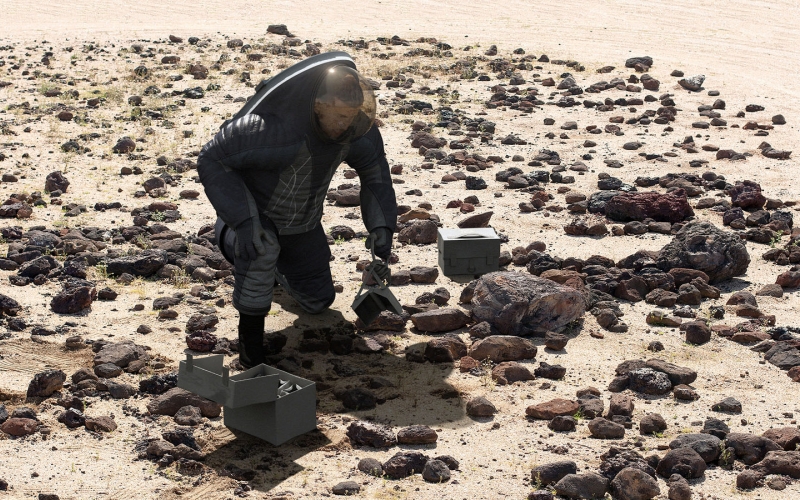After years of robotic exploration, NASA is now ramping up plans to send humans to space again. This ambitious strategy includes more spacewalks, construction of a station in lunar orbit, and eventually planetary exploration including the moon and Mars.
To pull this off, U.S. astronauts will need an updated suit. The current suit used for Extravehicular Activity (EVA) has been in service since 1981 with minimal updates and was not designed for the rigors of surface exploration including dust, radiation and other factors.
Two years ago, The Aerospace Corporation obtained a NASA contract to support NASA’s EVA Project Office at the Johnson Space Center in Houston, Texas. This includes assisting NASA with planning and executing spacewalks and advising on the development of a new EVA suit.
To catch up on NASA’s plans for spacewalks, planetary exploration and the redesign of the EVA suit, we caught up with Aerospace's David Adlis, assistant principal director, Johnson Space Center EVA Project, Human Exploration and Spaceflight Division.
How many spacewalks are planned for this year?
There are 10 to 20 International Space Station (ISS) spacewalks planned for 2019. This amount of EVA activity has not occurred since the height of the ISS assembly. Aerospace personnel are involved in all facets of EVA activity.
What do you attribute this increase in spacewalks?
A fairly steady number of them are for ISS repair and replacement. Launch delays resulted in several EVAs dedicated to the installation of new lithium-ion batteries on the ISS to be moved from last year to this spring. There are also as many as six EVAs required for repair of the Alpha-magnetic Spectrometer in the latter part of this year. It all adds up to a very busy year for EVA.

What kinds of new tool designs are in process or already developed to aid the crew during spacewalks?
There are hundreds of tools and crew aids that have been developed and built over the years for both Space Shuttle and ISS missions. The primary tools that have been in recent development are those being built by both JSC and Goddard Space Flight Center to enable spacewalk repair of the Alpha Magnetic Spectrometer, a major science payload located on the outside of the ISS. This repair will include the cutting of metallic cooling lines, the replacement of pump units, and the reattachment and swaging of the cooling lines with no leakage of coolant – none of this has ever been attempted by a suited astronaut in space so the work is quite challenging.
What kind of support does your group offer for the planning and execution of spacewalks on board the ISS?
The EVA Flight and Increment Management (FIM) Office is most involved in the planning and execution of ISS spacewalks. Aerospace has four EVA Flight and Increment Managers (FIMs) who function as the primary interface between the EVA resources and the ISS Program for EVAs. In addition, the group provides the primary EVA interface with the ISS International Partners. This includes everything from planning and requirements documentation all the way through verification/certification of flight/EVA readiness, launch, and real-time operations. Although the FIM group is the center of planning and execution, personnel in the EVA Hardware Office and Management Integration Office have critical roles as well, via processes, logistics, and design/certification of spacesuits, tools, and crew aids used in the spacewalk.
What is involved with pre-planning to ensure the safety of each spacewalk?
There are several processes in place to make sure EVA safety is addressed. During the hardware development process, the hardware providers have to verify that they meet EVA safety requirements. There is also an integrated safety assessment that is performed for each EVA. The completion of safety assessments, as well as discussions on any accepted risks, are addressed through the Certification of EVA Readiness process that culminates with final NASA approval at the ISS Mission Management Team Readiness Review.
What are the immediate goals of EVA Project Office and how many people do we have supporting NASA’s Houston office now?
We currently have more than 20 people supporting the EVA Office, and the collective goal is to keep the ISS in a safe and productive configuration, through the performance of maintenance and upgrade EVAs and to be ready to implement contingency spacewalks should the ISS encounter an emergency. We are also preparing for future EVAs beyond lower earth orbit in order to implement NASA’s exploration vision.

What is NASA’s exploration vision?
NASA is really planning a re-invigoration of America’s human space exploration. Space Policy Directive – 1 (December 2017) states: “Lead an innovative and sustainable program of exploration with commercial and international partners to enable human expansion across the solar system and to bring back to Earth new knowledge and opportunities. Beginning with missions beyond low-Earth orbit, the United States will lead the return of humans to the moon for long-term exploration and utilization, followed by human missions to Mars and other destinations.”
When the NASA Advisory Council met in August last year, the Human Exploration & Operations presentation charts led off with an EVA spacesuit front and center. We also have EVA personnel who already regularly work with the Russian, European, and Japanese space agencies in support of the ISS.
How is the Aerospace team improving the lifetime of the EVA exploration suit, and how is it progressing?
The EVA exploration suit is only in the early design phase and won’t enter service for years. The timing is really dependent on NASA exploration initiative and funding. The current spacesuit, the Extravehicular Mobility Unit (EMU) used for the Space Shuttle and the ISS, has been in service 1981 with relatively minor modifications.
One Aerospace employee is dedicated to the EMU, and supports NASA in assessments to increase the service life of the space suit assembly, or soft goods portion, while our EVA Deputy Chief Engineer is involved in all technical aspects. This support will help NASA extend the service life of the suit through the life of the ISS, which is currently slated to fly to 2024, but will likely be extended.
Getting back to the exploration suit, Aerospace personnel in the EVA Exploration Office are engaged primarily in systems engineering and integration, and have a great deal of responsibility for design requirements and milestone reviews for the exploration suit. The most tangible and specific tasks are the development and management of the numerous requirements documents for the exploration EVA system, which includes the new spacesuit and the airlock, as well as vehicle interfaces. We are also heavily involved in operational and design concepts for the exploration EVA system. The first rendition of the new EVA exploration suit, the xEMU Demo, is slated to operate on the ISS in 2023.

What are NASAs goals for a redesigned EVA suit? What does it need to be able to do that previous versions could not?
The current EMU was specifically designed as a microgravity suit to enable safing of the Space Shuttle Orbiter in a few emergency situations, such as closure of the payload bay doors. Over time the role of the suit expanded to satellite repair, culminating in repair and replacement of Hubble Space Telescope. Then came the major task of assembling the ISS, followed by current ISS operations – all in a Low Earth Orbit (LEO) “floating” suit. The EMU has admirably served in this role, with its life stretching nearly four decades - which was three decades longer than expected.
Regarding the future, it all comes down to requirements, requirements, requirements. NASA’s exploration destinations have additional demands for a spacesuit, such as dust tolerance and walking in partial gravity (two key differences found on the lunar surface) as well as increased radiation tolerance. The new suits will also be designed for longer life than the previous lunar (Apollo) spacesuits.
What challenges do you hope to address in the future for the EVA Office?
While we are addressing the increased frequency of EVAs for Space Station, we also have to efficiently move towards the future of EVA beyond Low Earth Orbit, including the development of a new exploration suit and associated hardware/equipment that meshes with lunar and Mars architecture. We expect that a concerted new exploration initiative by NASA will require “all hands on deck” for the EVA effort, and Aerospace, as a prominent team member, is spring-loaded to provide additional expertise.

